

Biological Sciences (Biology, Zoology, Microbiology) What are Biological Sciences?

From the OSU Biology Program, "Issues and advances in areas such as biotechnology, environmental science, medicine and other fields continually emphasize the importance of biology and biologists in the future of our country and the world. The Biology Program prepares students for diverse fields through broad, interdisciplinary training in the life sciences. Faculty teaching, research and mentoring expertise are drawn from the OSU Departments of Biochemistry and Biophysics, Botany and Plant Pathology, Microbiology, and Zoology.
" Biological Sciences study living organisms. Biological Sciences - What Can I Do with This Degree? Related Careers Related Skills Job & Internship Search Links USAJobs.gov - check out the Students and Recent Grads section and the Federal Jobs by College Major for a listing of job titles related to your major. Bio Careers - a job seeking database directed towards biological sciences. The Scientist: Careers Biotech Jobs Tiny Tech Jobs Nature Jobs. Neurotransmitters Contain Chemicals. Teacher Background Each of the billions of neurons in the nervous system communicate with one another and with other cells, such as muscle cells, through special junctions known as synapses.
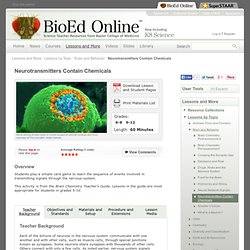
Some neurons share synapses with thousands of other cells. Others connect with only a few cells. As noted earlier, nervous system signals travel along the cell membranes of individual neurons, but what happens at the ends of neurons? How does a signal move across the synapse to other neurons? Nervous system signals generally travel in only one direction along a neuron. Biologists have identified more than 100 different neurotransmitters. Functional Ultrastructure. Biology, env. & Agriculture.
Biochemistry and molecular biology. Biotechnology. Ecology. Tree of Life on Earth. Animalia. Homo. Biology. Biology. Human Biology. Friends biology. ORGANICA. Nuerobiology. Other "life related" pearltrees. Nuerobiology. Taxonomy. Zoology. How to Build a Better Tree of Life. Illustration: Tyler Lang Organizing the world’s species into branches on a phylogenetic tree is a major goal of biologists trying to understand how life evolved.

DNA-sequencing technologies are providing them with more information than ever with which to accomplish this goal, but with less than 1 percent of all species currently placed in any kind of phylogeny, there is still much work to be done. In a recent paper in Science, researchers at the University of Texas at Austin introduced new tree-building software that could expand the tree of life and change our understanding of evolution.
One way to construct evolutionary trees is with software that compares and interprets discrepancies between the molecular sequences of different species using various statistical techniques. The robustness of the math driving these techniques largely determines the speed and accuracy of a given tree-building method. SATé solves another problem common among tree-building programs. Life on Earth. References Aravind, L., R.
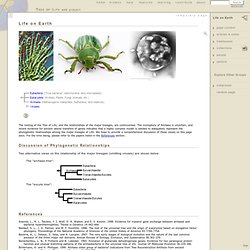
L. Tatusov, Y. I. Wolf, D. Baldauf, S. Becerra, A., L. Benachenhou, L. Tree of Life Web Project. National Center for Biotechnology Information. Phytochemical and Ethnobotanical Databases. Genomes OnLine Database - Home. Human Genome Project Information. Completed in 2003, the Human Genome Project (HGP) was a 13-year project coordinated by the U.S.
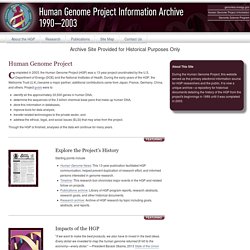
Department of Energy (DOE) and the National Institutes of Health. During the early years of the HGP, the Wellcome Trust (U.K.) became a major partner; additional contributions came from Japan, France, Germany, China, and others. The Human Genome Project. The Human Genome Project. The Human Genome Project, Part 3 The Ethics Behind the Human Genome Project What are the implications of the Human Genome Project?
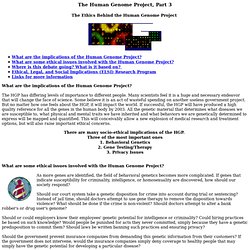
The HGP has differing levels of importance to different people. Many scientists feel it is a huge and necessary endeavor that will change the face of science. Some believe it is an act of wasteful spending on another useless government project. Human Genome Project - Mapping the DNA. Just over half a century ago, the world was not much aware about the contribution of the genetic factors towards human diseases.

The Human Genome Project was initiated to better understand the human DNA After the first correct description of the double-helix model of DNA (Deoxyribonucleic acid) structure in 1953 by James Watson and Francis Crick; certain methods were developed during 1970’s to determine the order, or sequence, of the chemical letters in DNA. Genome and Its Importance All our genes are collectively referred to as genome. In other words, genome is the entire genetic information, complement and all of the hereditary material possessed by an organism. Moellendorff's trinket snake videos, photos and facts - Orthriophis moellendorfi.
XClose Link to this photo Embed this ARKive thumbnail link ("portlet") by copying and pasting the code below.

Terms of Use - The displayed portlet may be used as a link from your website to ARKive's online content for private, scientific, conservation or educational purposes only. It may NOT be used within Apps. Read more about. Ce n'était pas une anémone : découverte d'un nouvel ordre animal au fond des mers. CNIDAIRES.
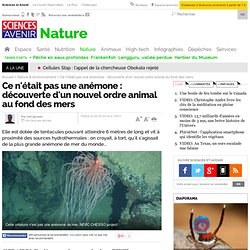
"La découverte de ce nouvel ordre de cnidaires - un phylum qui comprend méduses, coraux , anémones de mer – c'est équivalent à trouver le premier représentant d'un groupe comme les primates ou les rongeurs" explique Estefanía Rodríguez, du Museum d'histoire naturelle d'Amérique Avec son équipe, Estefanía Rodríguez publie dans la revue PLOS ONE le premier arbre phylogénétique des anémones de mers et d'autres animaux apparentés qui a conduit à la découverte d'un nouvel ordre animal. Un exemple d'évolution convergente Dotée de tentacules pouvant atteindre six mètres de long et vivant à proximité des sources hydrothermales, cette créature rebaptisée Relicanthus daphneae (anciennement appelée Boloceroides daphneae) ressemble à s'y méprendre à une anémone de mer. Mais "la considérer comme une anémone, c'est comme associer ensemble serpents et vers de terre, juste parce qu'ils ne possèdent pas de pattes" explique Estefanía Rodríguez.
"Imaginez ce qui nous reste à découvrir ! " List of biological sciences. An On-Line Biology Book. Wikispecies, free species directory.